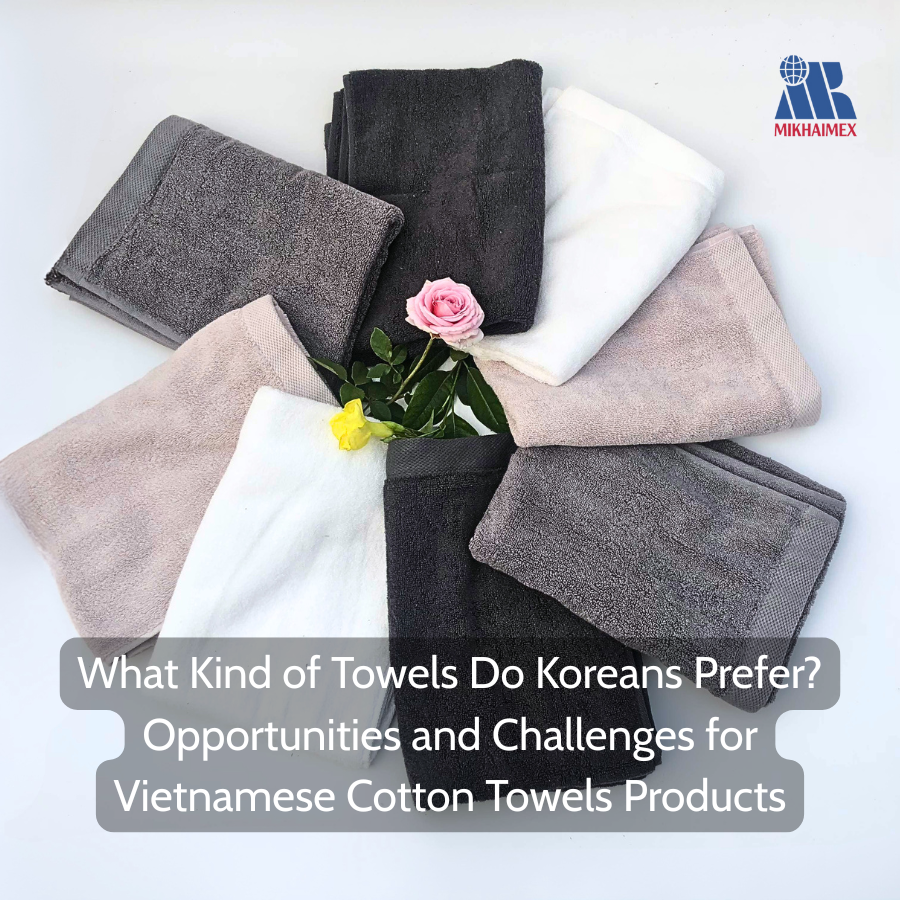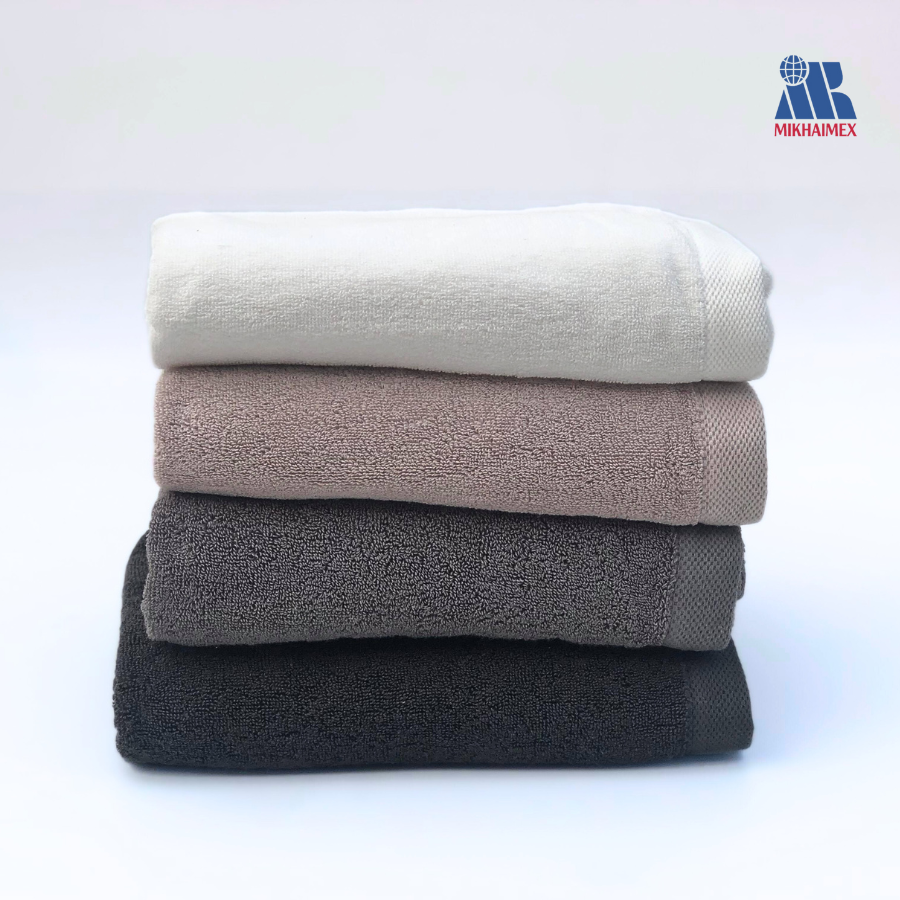What Kind of Towels Do Koreans Prefer? Opportunities and Challenges for Vietnamese Cotton Towels Products
1. Korean Consumer Preferences for Textile and Towel Products

South Korea is one of the most demanding consumer markets in Asia when it comes to quality, durability, and aesthetics in textile products. For Koreans, a towel is not merely a daily-use item but a reflection of a refined lifestyle, cleanliness, and self-care consciousness. They treat the choice of a good towel much like selecting a skincare product—because it comes into direct contact with the body every day.
Towels are used extensively in Korea: face towels, bath towels, spa towels, and even gift towels for weddings, housewarmings, or corporate events. This high consumption level has made Korea one of the most dynamic towel import markets in the region, creating significant opportunities for Vietnamese Cotton Towels, which are increasingly recognized for their consistent quality, diverse raw material sources, and competitive prices.
Korean consumers particularly value natural, eco-friendly products with international certifications such as Oeko-Tex or GOTS. Towels made from organic cotton, bamboo fiber, or recycled blends are highly regarded for their softness and skin safety. The most popular colors are soft shades such as white, beige, light gray, or pastel tones—symbols of purity and simplicity that align with Korea’s minimalist interior design style. This is a design trend that Vietnamese Cotton Towels can easily meet thanks to flexible weaving techniques and high customization capabilities.
Korean consumers also have a unique habit of using different towels for different purposes—face, hair, body, and public bath towels—which drives high per capita towel consumption. This provides Vietnamese towel producers with opportunities to expand exports across diverse segments, from hotel and spa towels to baby towels and gift sets.
Additionally, Korea’s distinct four-season climate greatly influences product preferences. During the humid rainy season and cold dry winters, consumers seek towels that absorb moisture well yet dry quickly without becoming musty. Products that strike a balance between absorbency and quick-drying performance—especially those made from hollow cotton or low-twist yarn—are highly favored. This is a segment where Vietnamese Cotton Towels excel, thanks to advanced weaving technologies and high-quality yarn materials.
2. Towel Market Trends and Imports in South Korea
In recent years, the Korean market has experienced a notable shift from basic, mass-market towels toward premium, eco-certified, and traceable products. This reflects the growing “green consumer” mindset—offering new opportunities for Vietnamese Cotton Towels to tap into higher-value segments.
Leading Korean brands like Songwol, Wonnam, and Daiso Hometex have set trends with soft, low-twist yarn towels and bamboo-fiber blends that enhance fluffiness and absorbency. However, the high domestic production cost in Korea has driven these brands to import large volumes of towels from other Asian countries with textile advantages—among which Vietnam stands out for its production stability and flexibility.
Currently, Vietnamese Cotton Towels account for a growing share of Korea’s import market, especially in segments like hotel, spa, and corporate gift towels. Korean trading firms appreciate Vietnam’s ability to customize designs, manage large-scale production, and maintain quality consistency. Beyond technical capacity, they also value the aesthetic sensibility and professionalism of Vietnamese manufacturers.
Moreover, Korea’s towel gifting culture—where towels symbolize cleanliness and refinement—places emphasis on design, scent, and packaging. With thoughtful investment in packaging style and brand positioning, Vietnamese Cotton Towels can easily capture the hearts of Korean consumers, who prioritize both quality and aesthetics.
3. Competitive Advantages of Vietnamese Cotton Towels in Korea
Vietnamese Cotton Towels hold several natural advantages when entering the Korean market. First, Vietnam has a long-standing textile tradition with a vertically integrated system—from spinning, weaving, dyeing, to finishing—supported by a skilled workforce. This enables Vietnamese manufacturers to fulfill large orders quickly, maintain quality consistency, and still offer competitive pricing.
Vietnamese producers have also invested heavily in modern weaving technology, using combed cotton, OE (open-end) yarn, bamboo, modal, and microfiber blends. This diversification allows Vietnam to cater to multiple Korean market segments—from high-end hotels and spas to household use.
Geographical proximity and the Vietnam–Korea Free Trade Agreement (VKFTA) further enhance competitiveness by reducing logistics costs and import tariffs. As a result, Vietnamese Cotton Towels can directly compete with Korean domestic products as well as imports from China and Thailand.
The growing sustainability movement in Korea also creates opportunities for Vietnamese manufacturers adopting eco-friendly practices—organic fibers, natural dyeing, and recyclable packaging—to penetrate premium retail channels. “Green production” is becoming a key purchasing criterion among Korean consumers, and Vietnamese suppliers who meet this standard will hold a long-term advantage.
4. Challenges Facing Vietnamese Cotton Towels
Despite strong potential, Vietnamese Cotton Towels still face several challenges in winning Korean consumers’ trust. Korea enforces stringent quality regulations—covering pH balance, color fastness, water absorption, and chemical residue safety. Without certifications like Oeko-Tex Standard 100 or ISO 9001, products will struggle to enter major retail systems.
Another challenge lies in brand loyalty. Korean consumers tend to stick with trusted brands, meaning Vietnamese producers must invest strategically in branding, packaging, and localized marketing. Price competitiveness alone is no longer sufficient; Korean buyers are willing to pay more for superior user experience and clear brand storytelling.
Compliance with Korean labeling requirements—such as material disclosure, washing instructions, and origin—must also be meticulous. Failure to meet these standards can result in shipment delays or rejections.
Lastly, aesthetic adaptation is essential. Korean towels are known for subtle elegance—light tones, minimalist patterns, and refined textures. Many Vietnamese products have traditionally favored bold colors, which may not suit Korean tastes. Therefore, adapting to minimalist design trends and emphasizing fabric quality will be key to elevating Vietnamese Cotton Towels in the Korean market.
5. Future Cooperation and Sustainable Development
As global supply chains restructure, Korea is increasingly collaborating with manufacturing partners that demonstrate both capacity and quality—among them, Vietnam is emerging as a preferred choice. Whereas imports were once limited to finished goods, many Korean brands are now shifting to OEM/ODM partnerships with Vietnamese factories, particularly those specializing in premium Vietnamese Cotton Towels.
Vietnamese manufacturers are moving beyond contract production toward co-designing materials, developing new models, and sharing innovation with Korean partners. This two-way collaboration not only enhances product value but also integrates Vietnamese Cotton Towels more deeply into the global supply chain.
Sustainability is becoming a non-negotiable standard. Korean consumers care about the production process, fiber sources, and environmental footprint. Certifications like GOTS, WRAP, and Oeko-Tex have become essential “passports” for Vietnamese products entering high-end retail systems. Many Vietnamese factories have invested in wastewater treatment systems, energy-saving dyeing processes, and bio-based chemicals—solidifying their reputation for clean, reliable production.
Vietnam–Korea cooperation extends beyond trade—it represents a strategic partnership built on shared values of quality, creativity, and sustainability. In the future, joint brand development between Korean distributors and Vietnamese Cotton Towel manufacturers is expected to flourish, helping Vietnamese products gain visibility and prestige across international markets.
6. Minh Khai Textile – A Leading Representative of Vietnamese Towel Manufacturing

Within Vietnam’s textile landscape, Minh Khai Textile Company stands out as a pioneer in producing high-quality towels. Established in 1973, Minh Khai has developed a fully integrated production system—from spinning, weaving, dyeing, and finishing to final packaging. With over half a century of experience, the company has mastered traditional craftsmanship while continuously upgrading to modern technologies that enhance fiber performance and production efficiency.
Minh Khai Textile offers a wide range of Vietnamese Cotton Towels, from premium combed-cotton towels to cost-effective OE (open-end) yarn towels. Their products are widely recognized for superior absorbency, color durability, and natural softness. Beyond domestic distribution, Minh Khai exports to several Asian markets, including Korea, Japan, and Taiwan.
The company places strong emphasis on sustainability. Its wastewater treatment systems meet international standards, energy-efficient dyeing methods are employed, and eco-friendly towel lines are actively being developed. Minh Khai also invests in packaging and branding to meet the refined expectations of international consumers.
The presence of Minh Khai Textile not only strengthens the global reputation of Vietnamese Cotton Towels but also exemplifies how Vietnam’s textile industry can evolve toward global integration. With a strategy rooted in quality, credibility, and environmental responsibility, Minh Khai continues to bridge Vietnamese craftsmanship with global consumers—especially in Korea, where elegance and quality go hand in hand.


